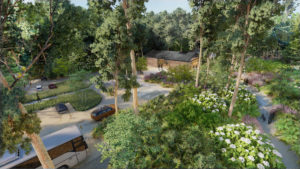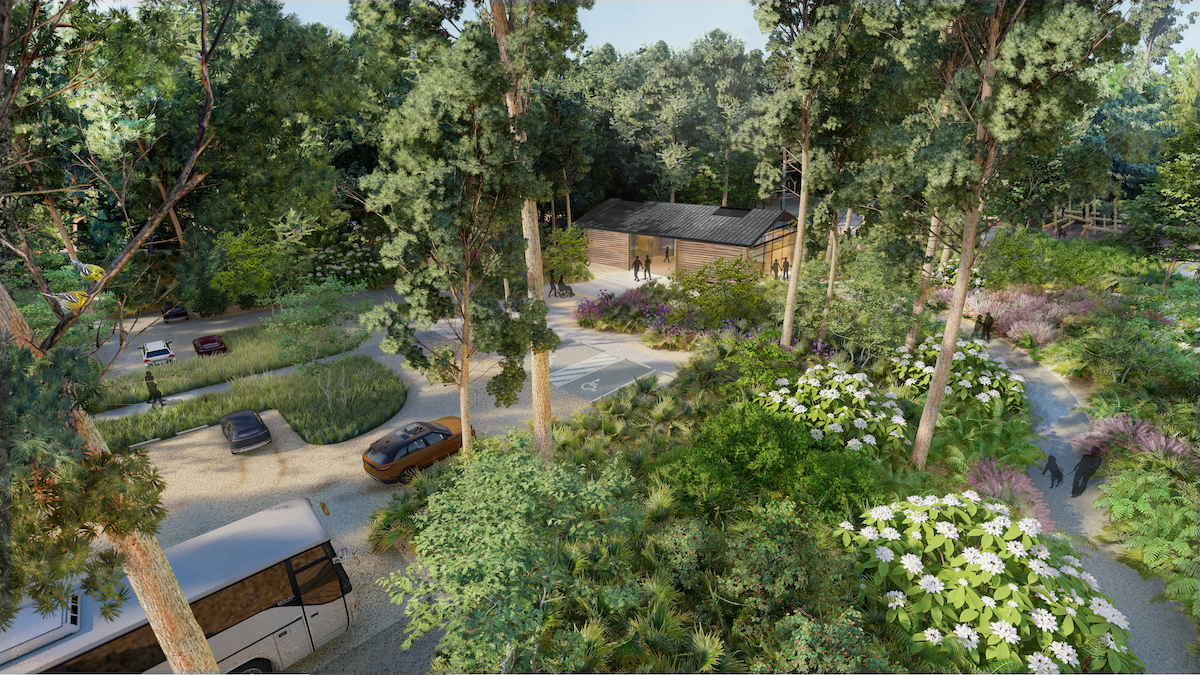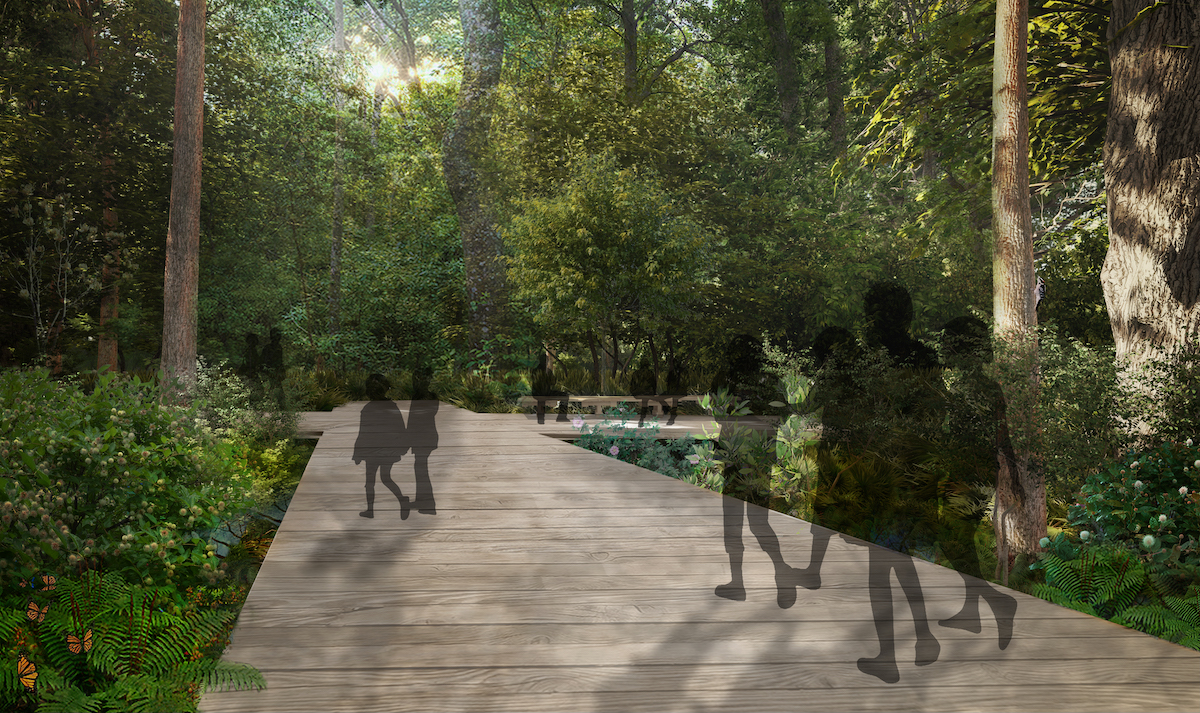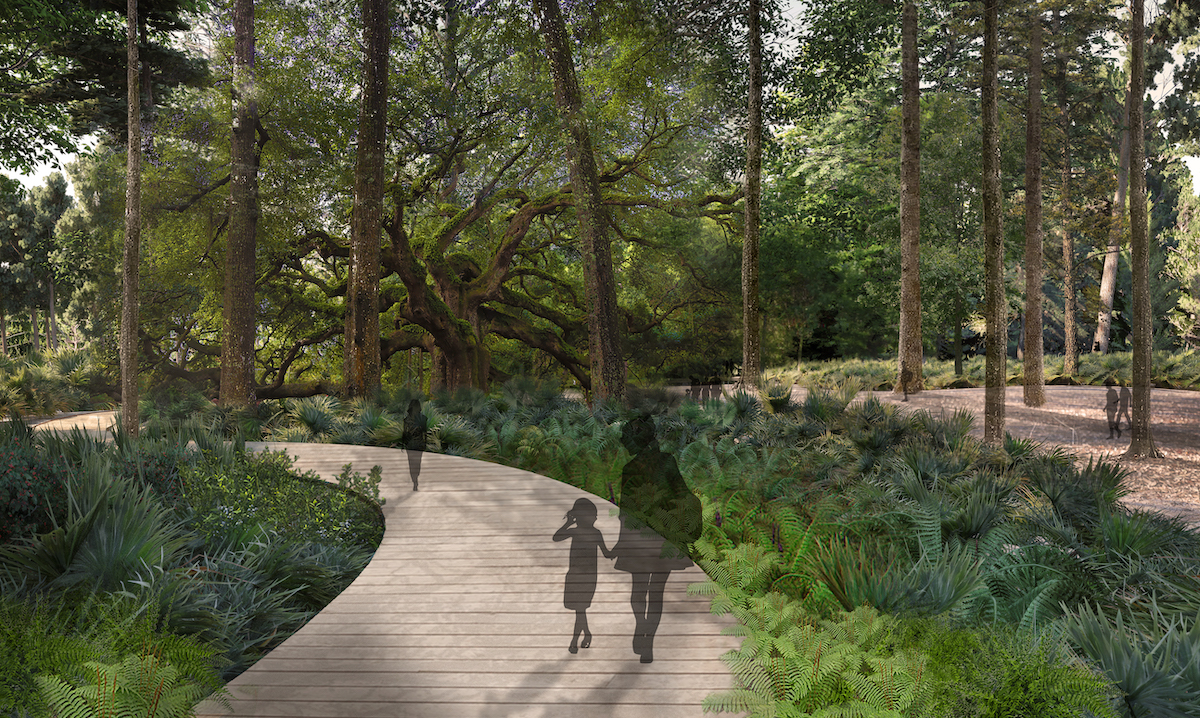THE FUTURE OF ANGEL OAK PRESERVE
Unrivaled in its features and accessibility, the 44-acre preserve design features boardwalk trails, a nature play area for children, and educational information about the tree and native people that have held the Angel Oak sacred. Charleston residents celebrate the magnetic draw of the enormous, centuries-old tree in the heart of Johns Island – and Lowcountry Land Trust is working to highlight this beloved local landmark symbolizing history, honor, and hope.
Lowcountry Land Trust is grateful for the support and leadership of the local community and particularly would like to thank South Carolina Representative Leon Stavrinakis for securing $3 million in foundational funding for the Angel Oak Preserve. The project’s total cost is expected to be $13.5 million, and fundraising efforts are underway.
Welcome Center Pavilion
The Welcome Center Pavilion will orient and provide visitors with the first impression of the Angel Oak Preserve. It will also provide restrooms, an information kiosk, and a gift shop. A forested drive buffering the parking from Bohicket Road will create a sense of arrival and immersion into the forest as visitors arrive at the parking lot. A Nature Play Area located in close proximity to the Welcome Center will allow for ease of access to its amenities and parking.
Boardwalks and Trails
The 44 acres surrounding the Angel Oak hold a diverse range of ecologies, all within Johns Island’s larger coastal ecosystem. Within the surrounding maritime forest are wetlands, elevated areas, and a mix of hardwood and pine trees.
Miles of boardwalks and trails will provide universal access to the preserve while protecting the more fragile ecologies. Interpretative moments will allow for opportunities to learn about the site’s historic hydrologic connectivity and the rich ecology that has shaped so much of Johns Island.
Historic Interpretation Opportunities
During the Angel Oak Preserve design process, archeologists revealed the imprints of the cabins of enslaved workers, as well as a plantation house and oak alleé. The rendered design proposes this as a critical moment for revealing the site’s layered history to visitors. Along the Preserve’s boardwalks and trails, visitors will have the opportunity to understand and interpret the history of the enslaved people and their contributions to the Johns Island community.
Angel Oak Trail
A vital aspect of the Preserve’s design is increased accessibility alongside the protection of the Angel Oak, its extensive root system, and surrounding plant communities. The new Angel Oak Trail is envisioned as an elevated ribbon of boardwalk on the perimeter of the Oak Grove that gently brings visitors to the site. The path widens at key moments allowing for seating and opportunities for interpreting the site’s ecological and cultural past – a deeply layered history of over 1,000 years.
FREQUENTLY ASKED QUESTIONS (FAQ)
We anticipate that we could begin construction of the Preserve in 2026. We are currently in the public permitting phase and are raising the funds needed to keep the project on the fastest possible timeline. We will ensure that the public is kept up to date.
Our intention is for the Angel Oak to be open and free to the public. We are exploring different financial models for long-term operations.
Yes. The Welcome Center Pavilion will orient and provide visitors with the first impression of the Angel Oak Preserve. It will also provide restrooms, an information kiosk, and a gift shop. A forested drive buffering the parking from Bohicket Road will create a sense of arrival and immersion into the forest as visitors arrive at the parking lot.
The Welcome Center is envisioned to link to the Preserve’s network of trails connecting the site’s cultural and ecological features with the Angel Oak. A Nature Play Area located in close proximity to the Welcome Center will allow for ease of access to its amenities and parking.
To protect the Angel Oak’s root system, the conceptual designs relocate parking away from the tree. The new parking area will be located at the Welcome Center Pavillion – an estimated 5 minute walk along an ADA accessible trail.
The current Angel Oak gift shop is located on top of the roots of the Angel Oak tree. At the new Angel Oak Preserve, the gift shop will be a part of the Welcome Center Pavilion near the parking lot.
Yes. The Angel Oak Preserve will include a nature play area for children so that they can climb, explore, and play in a safe environment. Family-friendly programming may also be available.
Yes. Miles of boardwalks and trails will provide universal access to the preserve while protecting the more fragile ecologies. Interpretative moments will allow for opportunities to learn about the site’s historic hydrologic connectivity and the rich ecology that has shaped so much of Johns Island.
The main trails will be 12 feet wide. Secondary trails will be 8 – 10 feet wide. The Angel Oak Trail leading guests to the tree will be 12 – 16 feet wide to allow for seating areas and larger groups of people.
There will be approximately 2.3 miles of main and secondary trails. 1.6 miles of these trails will meet City of Charleston ADA compliance codes.
Bicycles are not currently permitted at Angel Oak Park. The current conceptual designs do not allow for bicycle traffic but do include bicycle parking at some entrances.
Yes. During the Angel Oak Preserve conceptual design process, a historic site map revealed the location of three cabins of enslaved people, as well as a plantation house and oak alleé. The rendered design proposes this as a critical moment for revealing the site’s layered history to visitors. Along the Preserve’s boardwalks and trails, visitors will have the opportunity to understand and interpret the history of the enslaved people and their contributions to the Johns Island community.
In order to create a better visitor experience, we are working with the City of Charleston, Charleston County, and neighbors of Angel Oak Road to close the road to vehicular traffic (resident and emergency vehicles only).
A vital aspect of the Preserve’s design is increased accessibility alongside the protection of the Angel Oak, its extensive root system, and surrounding plant communities. Angel Oak Park is currently enclosed by a chain-link fence topped with barbed wire, and a yellow chain encircles the tree to prevent close access. The tree has been threatened by vandalism, and its long-term security is a priority as we transition the property into a 44-acre preserve. The tree currently receives as many as 400,000 visitors annually.
Therefore, threshold pavilions on both sides of Angel Oak Trail could double as a potential timed-entry kiosk. If utilized, visitors to the Angel Oak would need to register for a time slot for their visit to the tree on busy days so that the root system and security staff will be able to handle it. We do not anticipate charging for entry.
Our intention is to replace the current chain link fence with an alternative fence that has a larger perimeter, allows for further branch growth, is visually appealing, and highly secure. Our hope is that it will enhance the visitor experience while still ensuring the safety of the tree.
No, we will have micro bioretention at several locations that respond to the design, stormwater needs and the preserve’s ecological context. The traditional style retention pond you see in developments will not be used here.
We are finalizing operation details with the City of Charleston. We anticipate park hours will remain the same as they are now.

The magnificent tree known as Angel Oak, an icon of South Carolina’s Lowcountry region, is estimated to be centuries old. Native Americans once used the Angel Oak as a ceremonial meeting place.
The land surrounding the tree has also served as a plantation, a freedman's village, and a place where Johns Islanders, including Civil Rights activist Septima P. Clark, could rest under the shade.
In an interview from 1980, famous Civil Rights Activist Septima Poinsette Clark said:
“From the early days, Black people told their children stories about that tree. It was sacred, and it is sacred to them. Segregation was at its height, but the tree was not segregated. I don't really know who owned the tree, but they never segregated it so that we couldn’t go in. We would go in and have our picnic lunch, spend the day, the children would play under the tree, and then we would come back. There were ten black schools on the island and nearly all those teachers used the Angel Oak for their recreational programs."
In 2008, local nonprofit organizations like Coastal Conservation League and South Carolina Environmental Law Project, along with public entities, and community members, including LLT’s Angel Oak Project Manager Samantha Siegel, partnered to protect the tree and its surrounding ecosystem. The Angel Oak Effect is named after the grassroots effort that rallied and raised donations to save the tree after the surrounding 35 acres were approved for residential development.
A Grass-Roots Rally To Protect South Carolina's Massive 'Angel Oak'
Samantha Siegel’s relentless resolve to protect the Angel Oak
In 2013, after joining the community-wide effort, Lowcountry Land Trust purchased those surrounding 35 acres of significant forest and wetlands to protect the landscape in perpetuity. Significant private and public funding allowed for this purchase; including but not limited to South Carolina Conservation Bank and the Charleston County Greenbelt Program funds.
Lowcountry Land Trust proudly stewards the Angel Oak Preserve initiative - a 10-year effort to unify an existing 9-acre city park with the surrounding 35 acres once threatened by insensitive development. The Charleston community celebrates the magnetic draw of the enormous, centuries-old tree known as Angel Oak - and Lowcountry Land Trust is working to highlight this immersive ambassador site for environmental conservation through the creation of Angel Oak Preserve.
Local Stewards of the Angel Oak Reflect on What's to Come
Lowcountry Land Trust begins planning phase for Angel Oak Preserve project
Nelson Byrd Woltz tapped to lead planning process for South Carolina’s Angel Oak Preserve
Lowcountry Land Trust, in partnership with the City of Charleston and local stakeholders, announced that the near-final designs of the future Angel Oak Preserve are ready for community members to review and provide feedback. The announcement comes just eight months after the selection of award-winning landscape architects Nelson Byrd Woltz to lead a comprehensive planning process for the much-anticipated project.
Unrivaled in its features and accessibility, the 44-acre preserve design features boardwalk trails, a nature play area for children, and educational information about the tree and native people that have held the Angel Oak sacred. Charleston residents celebrate the magnetic draw of the enormous, centuries-old tree in the heart of Johns Island - and Lowcountry Land Trust is working to highlight this beloved local landmark symbolizing history, honor, and hope.
Community members can learn more about the project, review the design renderings, and provide feedback online at www.angeloakpreserve.org.
THE EBB & FLOW BLOG: ANGEL OAK PRESERVE

The Protected Path to the Angel Oak Preserve
Earlier this summer, Lowcountry Land Trust invited the public to help shape the future of the Angel Oak Preserve by suggesting names for the entrance road that will guide visitors

Future Angel Oak Preserve Recognized as Community Forest
Pictured above: Rendering of the Angel Oak Preserve’s commemorative walkway, which will honor the site’s cultural significance. Lowcountry Land Trust is thrilled to announce that the future Angel Oak Preserve

Community Engagement Opportunity: Help Us Name the Angel Oak Preserve Entryway
Lowcountry Land Trust is thrilled to invite the community to help name the new entryway road leading into the future Angel Oak Preserve. As part of our effort to protect

Angel Oak Preserve Update: April 2025
Since our last update in January, we have made significant progress thanks to your continued support and the powerful community spirit surrounding the Angel Oak Preserve. In early April, the




